Archived - What to expect with climate change?

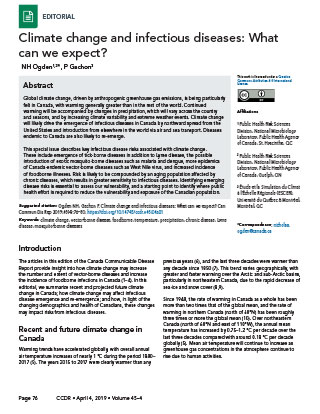 Download this article as a PDF
Download this article as a PDFPublished by: The Public Health Agency of Canada
Issue: Volume 45-4: Climate change and infectious diseases: The challenges
Date published: April 4, 2019
ISSN: 1481-8531
Submit a manuscript
About CCDR
Browse
Volume 45-4, April 4, 2019: Climate change and infectious diseases: The challenges
Editorial
Climate change and infectious diseases: What can we expect?
NH Ogden1,2, P Gachon3
Affiliations
1 Public Health Risk Sciences Division, National Microbiology Laboratory, Public Health Agency of Canada, St. Hyacinthe, QC
2 Public Health Risk Sciences Division, National Microbiology Laboratory, Public Health Agency of Canada, Guelph, ON
3 Étude et la Simulation du Climat à l’Échelle Régionale (ESCER), Université du Québec à Montréal, Montréal, QC
Correspondence
Suggested citation
Ogden NH, Gachon P. Climate change and infectious diseases: What can we expect? Can Commun Dis Rep 2019;45(4):76–80. https://doi.org/10.14745/ccdr.v45i04a01
Keywords: climate change, vector-borne disease, foodborne, temperature, precipitation, chronic disease, Lyme disease, mosquito-borne diseases
Abstract
Global climate change, driven by anthropogenic greenhouse gas emissions, is being particularly felt in Canada, with warming generally greater than in the rest of the world. Continued warming will be accompanied by changes in precipitation, which will vary across the country and seasons, and by increasing climate variability and extreme weather events. Climate change will likely drive the emergence of infectious diseases in Canada by northward spread from the United States and introduction from elsewhere in the world via air and sea transport. Diseases endemic to Canada are also likely to re-emerge.
This special issue describes key infectious disease risks associated with climate change. These include emergence of tick-borne diseases in addition to Lyme disease, the possible introduction of exotic mosquito-borne diseases such as malaria and dengue, more epidemics of Canada-endemic vector-borne diseases such as West Nile virus, and increased incidence of foodborne illnesses. Risk is likely to be compounded by an aging population affected by chronic diseases, which results in greater sensitivity to infectious diseases. Identifying emerging disease risks is essential to assess our vulnerability, and a starting point to identify where public health effort is required to reduce the vulnerability and exposure of the Canadian population.
Introduction
The articles in this edition of the Canada Communicable Disease Report provide insight into how climate change may increase the number and extent of vector-borne diseases and increase the incidence of foodborne infections in CanadaFootnote 1Footnote 2Footnote 3Footnote 4. In this editorial, we summarize recent and projected future climate change in Canada; how climate change may affect infectious disease emergence and re-emergence; and how, in light of the changing demographics and health of Canadians, these changes may impact risks from infectious diseases.
Recent and future climate change in Canada
Warming trends have accelerated globally, with overall annual air temperature increases of nearly 1 °C during the period 1880–2017Footnote 5. The years 2015 to 2017 were clearly warmer than any previous yearsFootnote 6, and the last three decades were warmer than any decade since 1850Footnote 7. This trend varies geographically, with greater and faster warming over the Arctic and sub-Arctic basins, particularly in northeastern Canada, due to the rapid decrease of sea-ice and snow coverFootnote 8Footnote 9.
Since 1948, the rate of warming in Canada as a whole has been more than two times that of the global mean, and the rate of warming in northern Canada (north of 60°N) has been roughly three times or more the global meanFootnote 10. Over northeastern Canada (north of 60°N and east of 110°W), the annual mean temperature has increased by 0.75–1.2 °C per decade over the last three decades compared with around 0.18 °C per decade globallyFootnote 5. Mean air temperature will continue to increase as greenhouse gas concentrations in the atmosphere continue to rise due to human activities.
By the 2070s, most of Canada is projected to be 5 °C warmer than in the period 1971–2000. Predicted changes in annual total precipitation include slight increases in precipitation in the Prairie provinces and greater precipitation (mostly rain) in northern and eastern Canada. However, projections for precipitation are associated with less robust estimates than those for temperature (Figure 1).
Figure 1: Projected increases in a) mean annual temperature (in °C) and b) annual total precipitation amount (in %) from 2017–2100 compared with 1971–2000
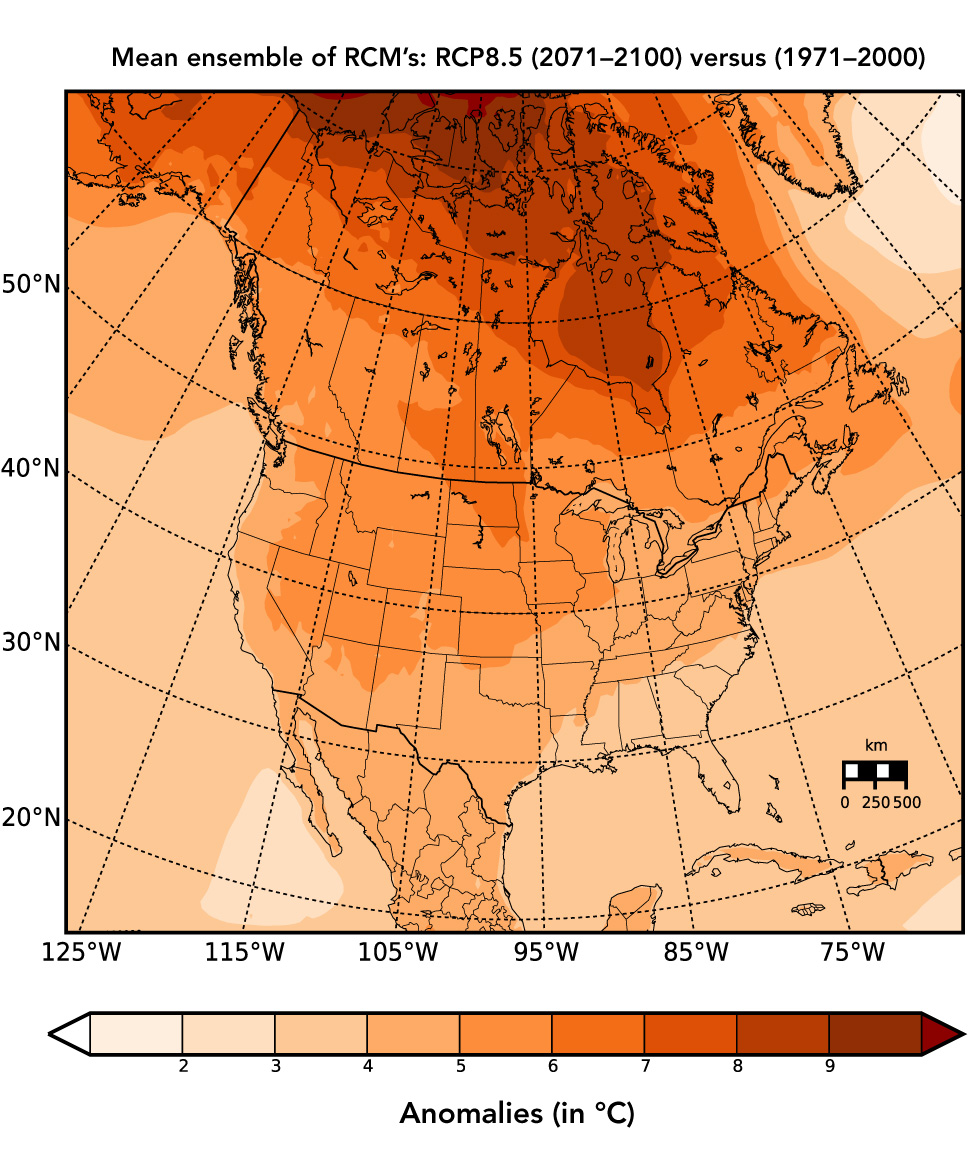
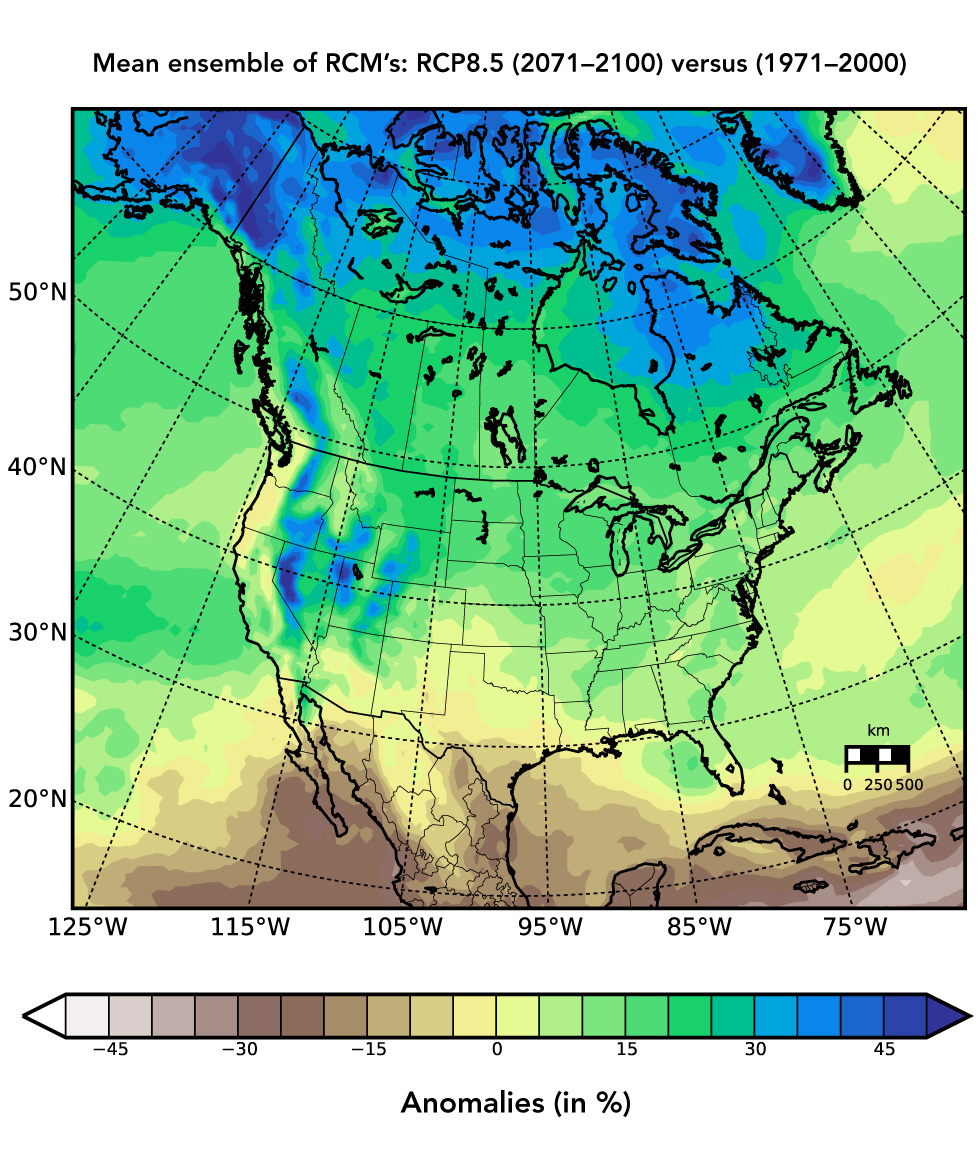
Text description: Figure 1
Figure 1: Projected increases in a) mean annual temperature (in °C) and b) annual total precipitation amount (in %) from 2017–2100 compared with 1971–2000
Figure 1 a)
This figure is a geographic heat map of North America that illustrates the projected increase in mean annual mean temperature (in °C) between 2071–2100 compared to reference period (1971–2000). This increase is demonstrated by a scale from 1 to 10 of shaded anomalies using the RCM (Regional Climate model) on RCP 8.5 (representative concentration pathway).
Figure 1 b)
This figure is a geographic heat map of North America that illustrates the projected increase in mean annual total precipitation amount (in %) between 2071–2100 compared to reference period (1971-2000). This increase is demonstrated on a scale from 1 to 10 of shaded anomalies using the RCM (Regional Climate model) on RCP 8.5 (representative concentration pathway).
In the future, warming is expected to be greater in northeastern Canada (up to 8.65 °C warmer by the 2070s) (Figure 2), linked with large declines in sea-ice and snow cover by the end of the 21st centuryFootnote 13.
Figure 2: Observed and projected annual changes in daily mean temperature over northeastern CanadaFigure 2 footnote a: 1948–2100 compared with 1971–2000
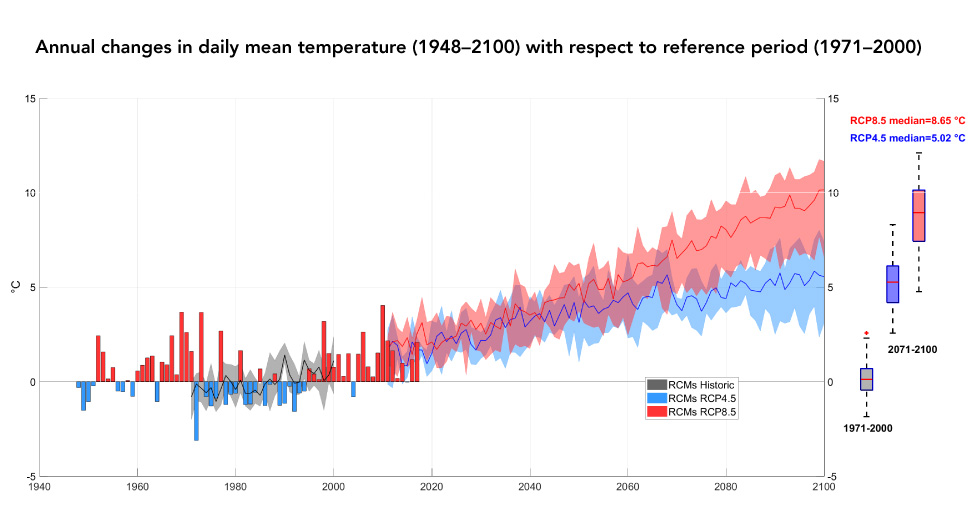
Text description: Figure 2
Figure 2: Observed and projected annual changes in daily mean temperature over northeastern CanadaFigure 2 footnote a: 1948–2100 compared with 1971–2000
This figure is a combined observed (bar graphs) and projected (line graphs) that reflects the annual changes in mean temperatures over northeastern Canada (land areas north of 60°N and east of 110 W) from 1948 to 2100 compared with temperatures during the reference period of 1971-2000.
Long-term changes in temperature and precipitation are expected to be accompanied by increased variability in temperatures and rainfall from one year to the next, as well as extreme weather events, including heat waves and heavy rainfall events that increases the risks of floodingFootnote 13. A significant increase in mean annual precipitation intensity per wet day (up to 15% by the 2070s), but fewer wet days per year, is anticipated in northeastern Canada where warming will be more pronounced over the course of the 21st century. Precipitation intensity is projected to increase substantially over time corresponding with the rate of warming, also affecting southern and eastern areas of Canada.
How climate change may affect infectious disease emergence and re-emergence
Over the past 10 years, we have seen the emergence and re-emergence of infectious diseases globally, including Ebola virus disease in Africa, Middle East respiratory syndrome coronavirus (MERS-CoV) in the Middle East and Zika virus disease, chikungunya, yellow fever and dengue in the Americas. These have posed great challenges for public health.
Infectious diseases emerge due to changes in their geographic ranges and by “adaptive emergence," a genetic change in the microorganisms infecting animals (usually wildlife) that results in these microorganisms becoming capable of infecting humans, and perhaps being transmitted from human to humanFootnote 14 – in other words a genetic adaptation that leads to a new zoonotic disease.
There are multiple drivers of disease emergence, including those associated with environmental (including climatic) changes; social and demographic changes including globalization; and changes in public health systems and policiesFootnote 15. Endemic diseases can re-emerge (i.e. increase in incidence or resurge as epidemics) associated with the same drivers. Climate and climate change may directly impact infectious disease emergence and re-emergence via effects on pathogen survival, arthropod vector survival and reproduction, contamination of water and, in the case of zoonoses, abundance of reservoir hosts (the animals that harbour the microbes). Such direct effects of climate change on the ecology, and transmission to humans, of infectious agents have been the focus of previous nationalFootnote 16Footnote 17 and international assessmentsFootnote 18Footnote 19Footnote 20. However, climate change may have indirect impacts on disease emergence and re-emergence, by affecting other environmental and social changes, and by impacting public health systems.
Effects of climate change on ecosystems, including effects on biodiversity, may alter the risk of a new zoonoses originating from wildlifeFootnote 21Footnote 22. In addition, climate change may negatively impact economies globally, particularly those of low and middle income countries. This may directly, or via increased frequency of conflicts, reduce infectious disease control and contribute to increasing densities of infectious agents in countries outside North America. Negative impacts on low- and middle-income economies may drive increased economic or refugee migration, increasing importation of infectious diseases into CanadaFootnote 23.
The combined effects of all these factors lead to three expected, broad impacts of climate change:
- Increased risks of introduction, and endemic transmission, of “exotic” infectious diseases (both directly transmitted and vector-borne) from around the world (e.g. Severe Acute Respiratory Syndrome [SARS])
- South-to-north spread of diseases currently endemic to the United States (e.g. Anaplasmosis)
- Re-emergence (i.e. more epidemic behaviour and range change) of Canada-endemic infectious diseases (e.g. West Nile virus outbreaks) (Figure 3).
Figure 3: A summary of climate change effects on infectious disease risks for Canada Figure 3 footnote a
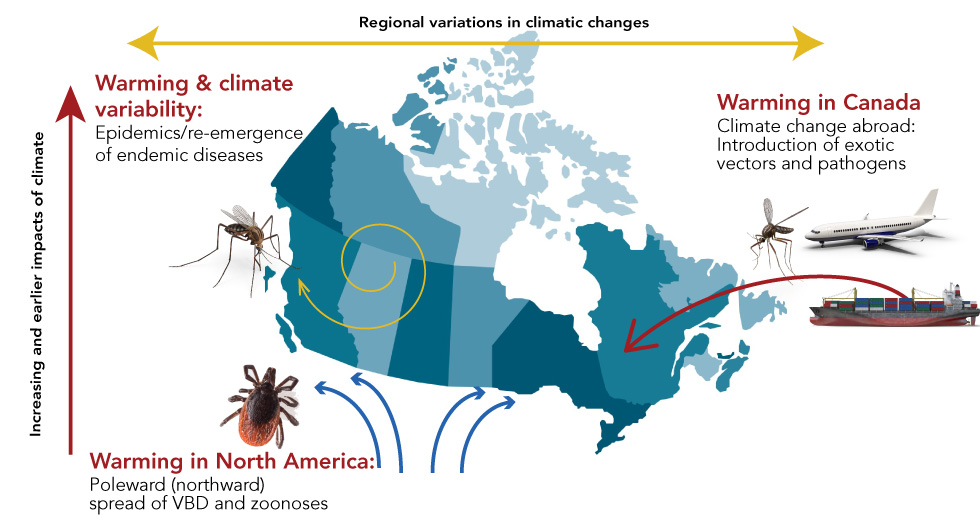
Text description: Figure 3
Figure 3: A summary of climate change effects on infectious disease risks for Canada Figure 3 footnote a
This figure is a graphical illustration that summarizes the climate change effects on infectious disease risks for Canada. The long-term climate changes and increased climate variability will affect the different infectious disease risks:
- Warming & climate variability will cause the Epidemics/re-emergence of endemic diseases
- Warming in Canada and climate change abroad will introduce exotic vectors and pathogens
- Warming in North America: Poleward (northward) will lead to the spread of VBD and zoonoses
The long-term changes in temperature and precipitation, increased climate variability and increased frequency of extreme weather events described above will affect the different infectious disease risks idiosyncraticallyFootnote 24. Modelling studies are increasingly being developed to assist with the prediction of effects of climate change on infectious diseases to allow us to be better prepared for these changing risks.
Other factors to consider
Changing patterns of infectious diseases in Canada due to climate change also need to be considered in the context of other disease trends associated with the changing demography and health of Canadians.
The Canadian population is aging and increasingly affected by chronic illnesses. This means that both infectious and chronic disease risks will need to be considered togetherFootnote 25. The risk from infectious diseases comprises two aspects: the likelihood of exposure and sensitivity (i.e. severity of infection outcome). Exposure likelihood depends on the number of infective organisms (the “hazard”), that is, infective humans, microorganisms, arthropod vectors and animal reservoir hosts, in our environment and the rate of contact of humans with infectious organisms. These will likely increase with climate change. At the same time, the severity of infectious disease outcomes will likely be greater in populations that are increasingly elderly and affected by chronic diseases. This seems to be the case for vector-borne viruses such as West Nile virusFootnote 26.
Conclusion
Canada’s climate is changing. With increased temperatures and spatial and temporal variability in precipitation patterns, this will likely increase the risk of acquiring Lyme disease and West Nile virus, already well-established in Canada, as well as other tick-borne, mosquito-borne and foodborne diseases. More detailed overviews of current and projected from climate change–mediated infectious disease risks are presented in the articles in this issue. Risk is likely to be compounded by the fact that in Canada we have an aging population increasingly affected by chronic diseases who may develop more severe infections than the young and healthy. Identifying these risks is a key activity to assessing our vulnerability as a nation, and a starting point to identifying where public health effort is required to reduce the vulnerability and exposure of the Canadian population.
Authors’ statement
NHO and PG conceptualized and co-wrote the article, NHO provided the public health and infectious diseases components and PG provided the information on climate change.
Nicholas Ogden was the Guest Editor of this issue of CCDR, but recused himself from taking any editorial decisions on this manuscript. Decisions were taken by the Editor-in-Chief, Dr. Patricia Huston.
Conflict of interest
None.
